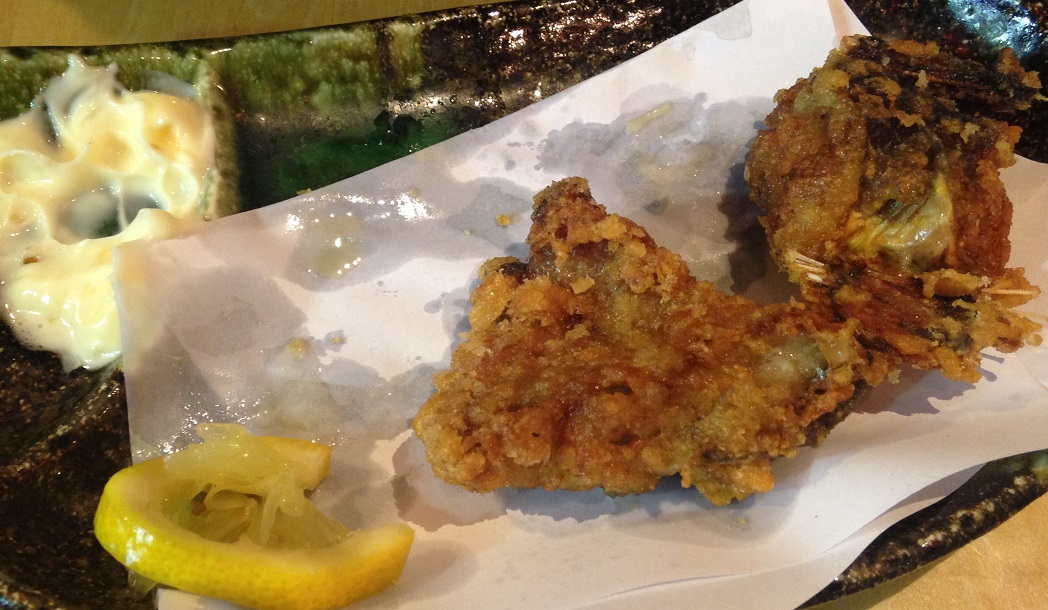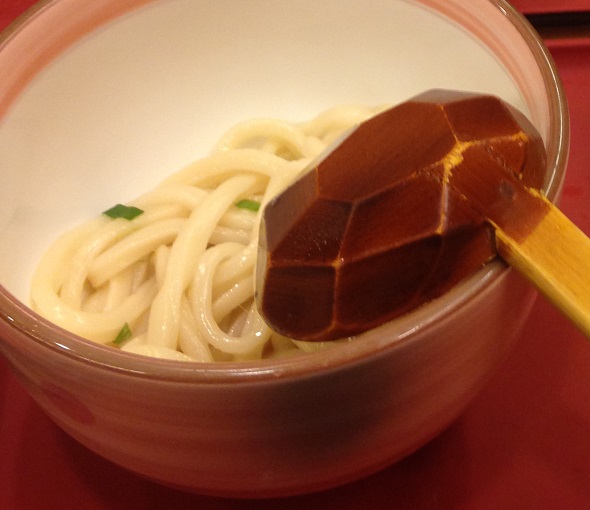If you say “Japanese food,” most Westerners think of sushi. But it turns out that sushi is only one of a broad range of Japanese cuisines. They include:
- Izakaya: This is like the Japanese version of BBQ. These restaurants are known for their meat grills: common offerings include kushiage (skewers of deep fried meat and vegetables) and yakitori (skewers of grilled chicken). Sides can be everything from fried rice to oshinko (pickled vegetables). Beer is practically mandatory here. Food is served and eaten tapas-style: shared by the whole table and often ordered in rounds.
- Yakiniku: This is the Japanese version of Korean BBQ, which is where you grill meat yourself at your table. Beer and sides are common here too, but it’s more of a DIY environment, where seasoning and sauces are up to you, not to the chef.

- Tempura: This is Japenese fried food. Vegetables, shrimp, or meat are coated in a thin breading that’s light brown in color. The difference between freshly-fried and older tempura is pretty noticeable. Izakayas (above) may serve it, and there is some tempura sushi rolls (more so in the US than in Japan), but there are places that specialize in tempura alone.
- Ramen: Another popular type of food – and restaurant – is ramen. These are wheat noodles served with pieces of pork in a pork broth. If you’re imagining the ramen ready-to-eat noodles they sell at US grocery stores, you are not even in the right ballpark. Think of a hearty stew, with the popularity of chili, and you’ll be closer.
- Soba: This is also a type of noodle, but it’s made from buckwheat (just like grechka, for you Russian food lovers out there). It can be served like a noodle – with a sauce or toppings, or in a soup – like ramen.
 Udon: This is also a wheat noodle, but thicker than ramen and also served either in a soup or as a noodle dish. There are dozens of popular types, like kitsune udon (udon noodle soup with a piece of sweet, fried tofu).
Udon: This is also a wheat noodle, but thicker than ramen and also served either in a soup or as a noodle dish. There are dozens of popular types, like kitsune udon (udon noodle soup with a piece of sweet, fried tofu).- Crepes: The Japanese borrowed this from the French, for whom they seem to have a profound food admiration, based on the number of French restaurants they have. This is street food in Japan, and fillings are often sweet and smothered in whipped cream. Though their popularity is high, don’t expect these crepes to taste anything like French crepes.
- Curry: Another import is curry. Japanese-style curry (called Kare Raisu) tends to be a plate of half rice and halfand meat, covered in a dark brown-colored curry sauce. There is more quantity of curry sauce than I’ve seen elsewhere, but it tastes pretty good. There is a particularly popular chain of restaurants that offer this.
 Okonomiyaki: This cuisine is said to have evolved from the practice of cooking left-overs in a pancake batter. The translation is “whatever you like grilled,” and it’s basically a pancake made of batter, cabbage, other vegetables, and meat or seafood. There’s also a version that has (lo mein-like) noodles inside. The ingredients are gathered in the kitchen, but they are poured out onto the grill that makes up your table, and then left to cook in front of you. The waitress comes back over to turn it, and to put sauce on it – if you like. The brown sauce (pictured) is like a sweet BBQ sauce, but when you put some spicy mayo on as well, the two combined are delicious.
Okonomiyaki: This cuisine is said to have evolved from the practice of cooking left-overs in a pancake batter. The translation is “whatever you like grilled,” and it’s basically a pancake made of batter, cabbage, other vegetables, and meat or seafood. There’s also a version that has (lo mein-like) noodles inside. The ingredients are gathered in the kitchen, but they are poured out onto the grill that makes up your table, and then left to cook in front of you. The waitress comes back over to turn it, and to put sauce on it – if you like. The brown sauce (pictured) is like a sweet BBQ sauce, but when you put some spicy mayo on as well, the two combined are delicious.- Takoyaki: Though it sounds similar to okonomiyaki (to Westerners), this is not very similar. This is served primarily at street vendors that specialize in it, not at restaurants – and you don’t cook it yourself. These look like donut holes, but they’re made of savory battery, filled with fresh octopus pieces. A serving is usually eight of them, covered in sweet sauce, mayonnaise, and bonito flakes. (I think they taste like pork, for some reason.)
- Shojin: This is traditional Japanese Buddhist cuisine. They say that while in most East Asian countries, Buddhist cuisine is strictly vegetarian, in Japan, it occasionally has meat or fish. We experienced only the vegetarian variety, tapas-style, and it bordered on haute cuisine – not too dissimilar from our experience at the fancy restaurant in Budapest.
 Donburi: My favorite kind of donburi is pieces of tuna and salmon mixed into a bowl of rice with scallions, wasabi, pieces of seaweed, and cabbage. I liked it so much that we went to the same donburi chain restaurant! twice – and would have gone more, if I had found another location. But actually, donburi just describes a bowl of rice with something on top – whether meat or fish or eel (unagi), mixed in or just as a topping, cooked or not. This seemed like the most common type of chain restaurant in Japan, perhaps because the number of things you can put on or in rice are legion. The most common toppings seemed to be beef tendon (called Gyudon) and breaded fried pork (called Tonkatsu).
Donburi: My favorite kind of donburi is pieces of tuna and salmon mixed into a bowl of rice with scallions, wasabi, pieces of seaweed, and cabbage. I liked it so much that we went to the same donburi chain restaurant! twice – and would have gone more, if I had found another location. But actually, donburi just describes a bowl of rice with something on top – whether meat or fish or eel (unagi), mixed in or just as a topping, cooked or not. This seemed like the most common type of chain restaurant in Japan, perhaps because the number of things you can put on or in rice are legion. The most common toppings seemed to be beef tendon (called Gyudon) and breaded fried pork (called Tonkatsu).- Kaiseki-ryori: We never got to try this multi-course chef’s choice dinner that was particularly popular in Osaka. They say that it is extremely creative and can have up to fourteen courses! And, of course, you pay for that extravagance.
- And, of course, Sushi: The types of fish available in Japan are similar to the ones we can get in the US, though they tend to be much more fresh.
In addition to these cuisine styles, there were also some specific foods that we saw:
- Natto: This is a “dish” of fermented beans. It has the stickiness of kids’ glue, unfortunately, so many people don’t find it appealing. People claim that it is a popular breakfast food, though we mainly saw it as a sushi roll filling. I wouldn’t say it’s awful, but I would never go out of my way to eat it, personally.
- Sukiyaki: This is Japanese hot pot. It’s thinly-sliced beef, vegetables, and noodles cooked in a stew or soup, and it’s often dipped in raw eggs before being eaten. This is primarily a winter food, the Wikipedia page says, which may be why we didn’t see much of it.
- Korokke: Like crepes, this word seems to come from the French word croquette. We might call it an oblong meatball. It is commonly filled with pork (making it resemble tonkatsu, above) and then put between two slices of bread to make a sandwich. Actually, the tourism commercials encouraging Japanese people to explore Tokyo featured the woman tourist going to a restaurant that served her one of these!
- Matcha: This is powdered green tea, and it tastes exactly like that – which is to say that it’s not particularly sweet. It is commonly used in desserts, though I think Westerners expect these delicacies to be sweeter than they actually are.
- Yatsuhashi, Senbei and Kaminari-okoshi: These are various types of sweets sold all over. They are generally all quite saccharine, with a few different textures: cracker-like and crunchy, peanut-like and chewy, or fruit leather-like and sticky.
- Melonpan: This is a Japanese bun that is said to taste like melon. Presumably, the name is taken from the Italian?
- Kakigori: This is the Japanese version of shave ice, similar to Malaysian kacang, Chinese baobing, or Korean patbingsu. In any language, it’s ice, with sweetened syrup, sweetened condensed milk, and fruit or mochi toppings.
- Taiyaki: This is the Japanese version of the fish-shaped red bean pastries we ate in South Korea.



Ah yes, the yakitori with rectal meats. Good times!
Just a couple more for the list 🙂
Gyoza
Mochi
Melonpan
Taiyaki
Unagi
Great additions!